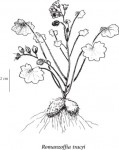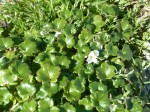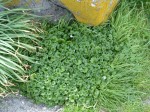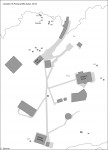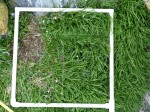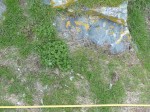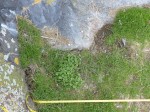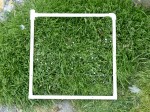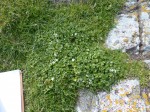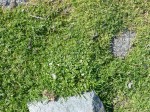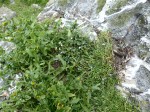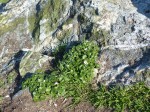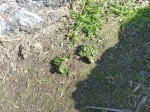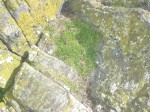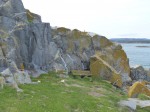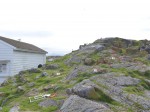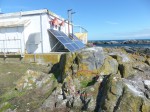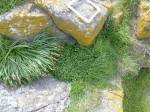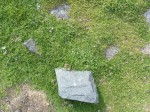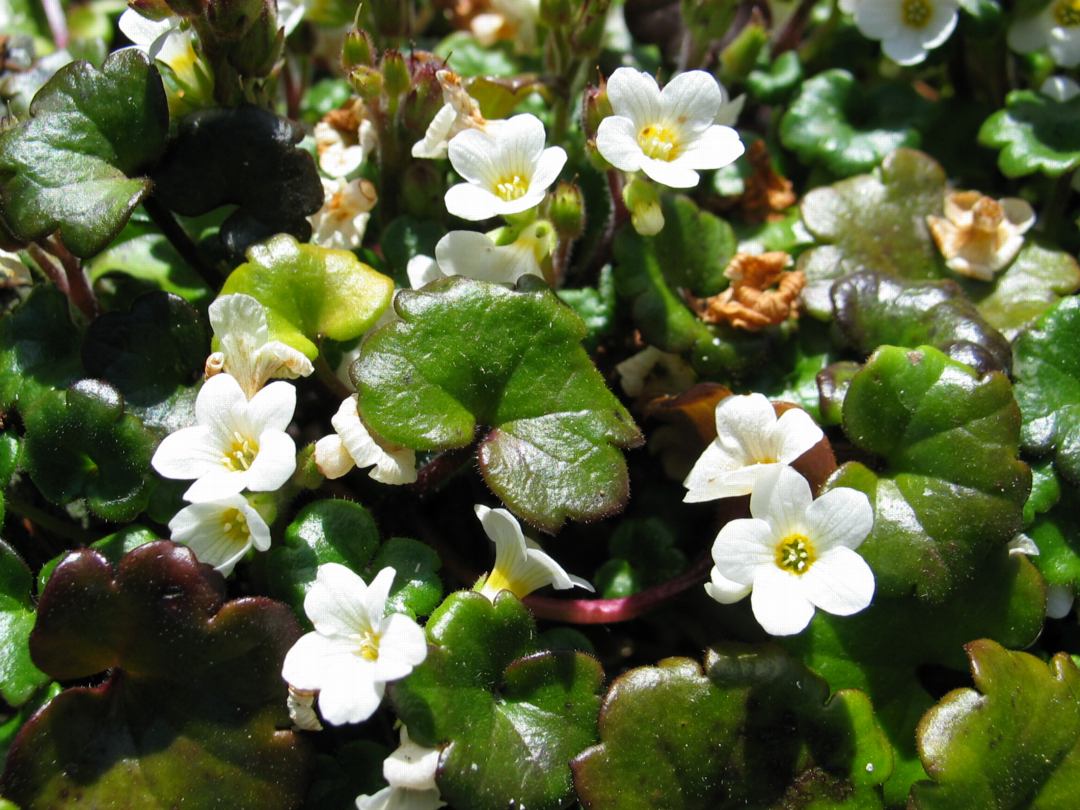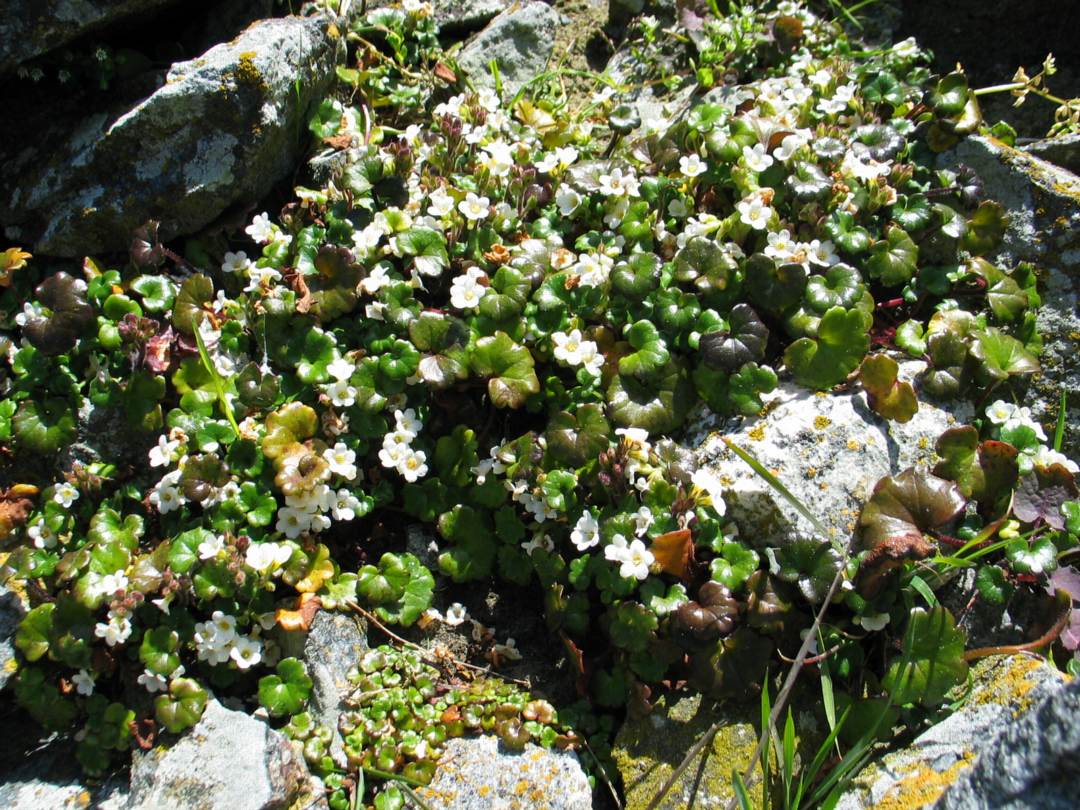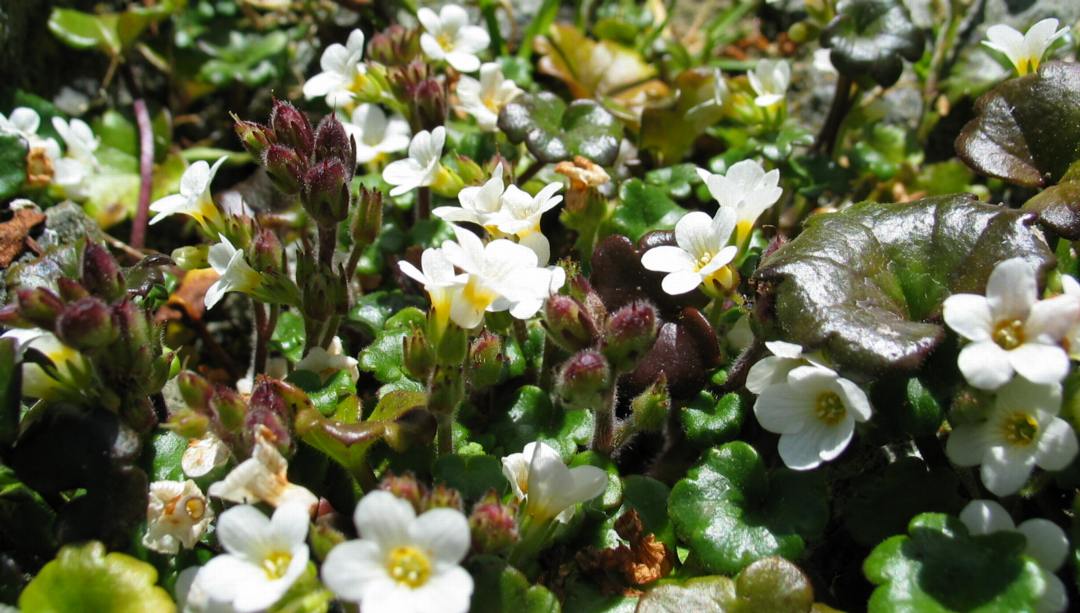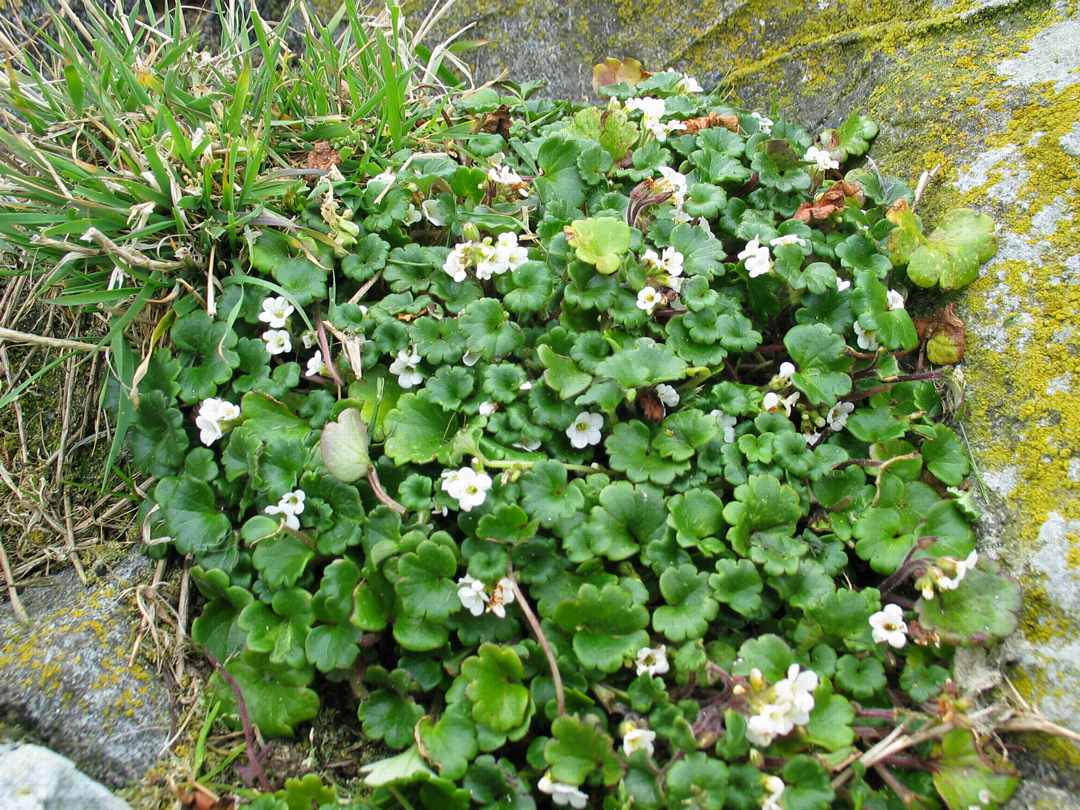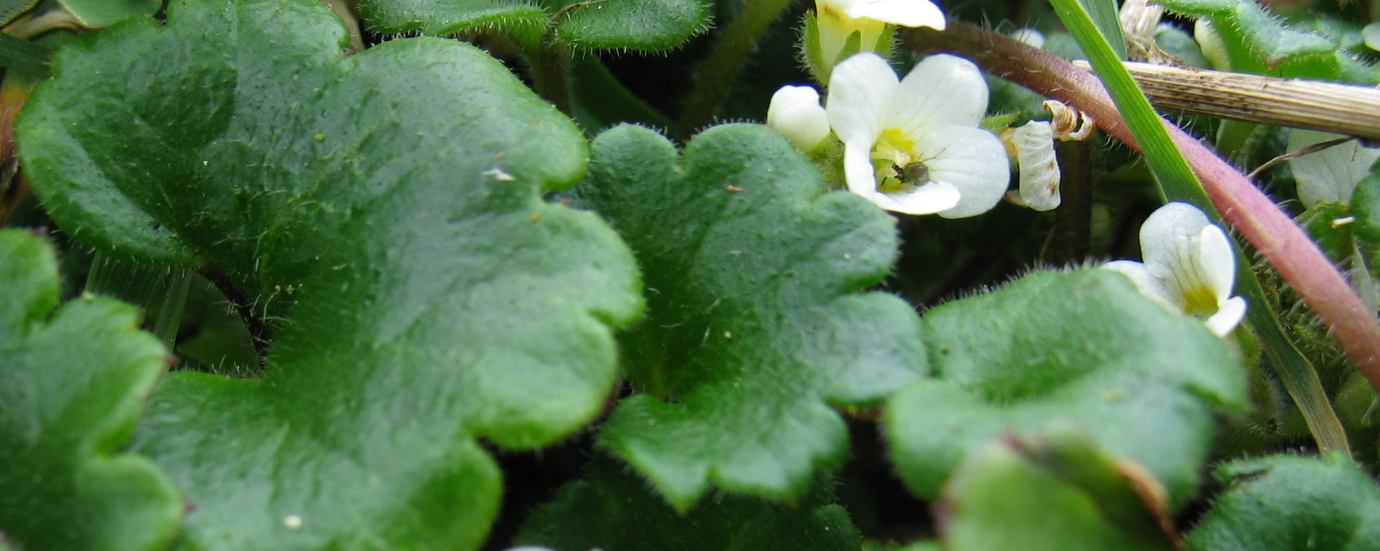Romanzoffia tracyi
Scientific classification
Family: Boraginaceae (Borage)
Subfamily: Hydrophylloideae (Waterleaf)
Genus: Romanzoffia
Species: R. tracyi (Jepson)
Common name: Tracy’s mistmaiden
- Botanical drawing
- Close up
- B1
- Locations of R Tracyi (2014)
General: Perennial herb from well-developed, brown-woolly basal tubers; stems several, ascending, long glandular-hairy, 2-12 cm tall [1].
[Here is a link to a pdf copy of the 2014 plant survey Romanzoffia tracyi]
Leaves: Basal leaves numerous, the blades round to kidney-shaped, 1.5-3 cm wide, palmately veined, shallowly lobed or coarsely toothed, stalks 1-8 cm long with expanded, overlapped, slightly thickened bases, these soft-hairy on the margins; stem leaves similar, few, reduced upwards [1].
Flowers: Inflorescence of several short-stalked flowers in a compact, terminal cluster; corollas white, usually with yellow centres, 6-8 mm long and wide; calyces equal to or longer than the clefts of the corollas, the lobes linear-lanceolate, soft-hairy [1].
Fruits: Capsules, 2-chambered; seeds numerous [1].
Habitat/Range: Mesic to moist coastal bluffs in the lowland zone. It is always found within 30 m of the salt spray zone on rocky cliffs and bluffs. It can be found as far South as California up to the Southern half of Vancouver Island. It is considered to be rare on Southern Vancouver Island [1].
Status: The status of the plant varies depending on the particular list. R. tracyi is listed as ‘Yellow’ on the BC List which means that its status is considered to be secure and not at risk of extinction. It is common for Yellow-listed species to have red- or blue-listed subspecies. Its Provincial Status is ‘S3S4’ which means that it is a species of special concern because it is vulnerable to extirpation or extinction. It is not listed under COSEWIC [2].
Nomenclature: Romanzoffia honors Nikolai Rumiantzev (1754-1826), better known as Count Romanzoff, a Russian sponsor of Kotezebue’s expedition to the Pacific Northwest. Tracyi is for Samuel Mills Tracy (1874-1920), a botanist with the U.S Department of Agriculture [3].
Similar Species: Sitka Mistmaiden (R. sitchensis) is a related species that grows on wet cliffs and rocky outcrops in the Cascade Mountains and Columbia River Gorge [3].
Phenology: On islands in near-by Barkley Sound, R. tracyi is considered to be ‘commonly uncommon’ in that it displays uniformly low frequency of occurrence across a wide range of island sizes. It also has a dynamic colonization-extinction pattern (C + E = 36). It appears that, while this shoreline species is technically a perennial, the “vagaries of life near the surging surf mitigates against persistent populations in most plants that occupy the lower shoreline, and favours good recolonization ability” [4].
Occurrence at Race Rocks: For several years two small patches of R. tracyi grew on the center of Great Race Rock. One patch was at the very top of the highest rock cliff on Great Race but disappeared by 1988. The other patch, ~5 meters NW of the boathouse, was obliterated in the late 1970s by the rock blasted for the helicopter pad. Since the mid 1990s the boathouse patches have re-established and are scattered among the large rock rubble close to the original growing location. In 2000, a new site was found East of the SE corner of the Keeper’s House. A floristic survey done of Great Race in the spring of 2001 by two Pearson College students (Julia and Taarini) documented several patches of R. tracyi in a number of new locations, notably off the SW corner of the Keeper’s House. In 2013 Garry Fletcher documented a patch a few meters from the SW corner of the Energy Building. A survey in 2014 by Courtney Edwards found several of the patches noted since the 1990s, as well as several new ones; including several clumps around the base of the West camera bluff (see map).
Noted during the 2014 survey, the plants are easiest to locate in early to mid spring. Near the onset of dry season many of the smaller patches ‘die-back’, possibly from the dry weather since this species prefers moist locations. Some patches are covered over by grasses starting in May. One patch below the camera bluff was disturbed by a Gull building a nest on it. The patch by the Energy building suffered damage from the Sea lions in Fall 2013.
2014 Survey: The R. Tracyi survey was conducted in April of 2014, first by checking pre-existing locations and then by actively looking for patches in nearby areas. The patches can be found four main locations on Great Race Rock: around the West Camera bluff, to the North-West of the Boat Shed, East of the Keeper’s House, and West of the Energy Building (Figure 2). Each general area has been assigned a letter code (A-D). Each patch is numbered and can be located by taking a measurement and magnetic compass bearing from a particular object:
A1-A2: secure the tape to the bottom NW corner bolt of the camera base and head down the bluff to the North ledge.
A3-A4: wedge the tape under the bottom corner of the big North boulder and look around the base of the cliff.
B1-B3: wedge the tape into the edge of the NW corner siding on the boathouse. The three patches are on separate rock steps above the boathouse.
C1: wedge the tape into the edge of the NE corner siding on the house. The patch is on the very edge of a rock bluff.
C2: wedge the tape into the edge of the SE corner siding on the house.
D1: secure the tape to the edge of the Energy Building.
R. Tracyi patch area was visually estimated using 0.25m (625cm2) or 0.5m (2500cm2) quadrats with 5cm2 fishing-line divisions.
| Bearing (°Mag) | Distance (meters) | Measured from: | Area (cm2) | ||
| Camera Bluff | |||||
| A1 | 306° | 7.0 | camera | 1610 | |
| A2 | 320° | 7.0 | camera | 725 | |
| A3 | 170° | 1.7 | rock | 881 | |
| A4 | 170° | 4.4 | rock | 270 | |
| Boatshed | |||||
| B1 | 282° | 9.0 | NE corner | 2500 | |
| B2 | 304° | 7.5 | NE corner | 1118 | |
| B3 | 316° | 4.4 | NE corner | 625 | |
| Keeper’s House | |||||
| C1 | 026° | 10.0 | NE corner | 50 | |
| C2 | n/a | n/a | SE corner | n/a | |
| Energy Building | |||||
| D1 | n/a | n/a | SW corner | n/a | |
| Table 1: Results of the 2014 R. Tracyi survey showing location of each patch from a bearing along a measuring tape and the total area of each patch. Unable to survey C2 and D1 because they disappeared between locating them and surveying them. | |||||
2014 Survey Comments:
A1: A single patch right up against the wall of the cliff. A Gull had started making anest in this patch in May.
A2: A single patch right up against the wall of the cliff to the East of A1.
A3: Two main patches against the base of the cliff, and two small ‘satellite’ patches a little further out.
A4: A single patch right up against the base of the cliff.
B1: Wedged into a small pocket in the rocks, this is a fairly large, healthy looking patch. It is thicker and taller than any of the others, maybe because it is in a shady pocket.
B2: A single patch, not very tall. Mostly covered over by grass in May.
B3: A single patch next to a small square-ish rock. Totally covered over by grass in May.
C1: A single small patch on the edge of a rock. Lots of Gull and Goose action in this area.
C2: Found a few tiny plants on the preliminary survey, but not able to locate it a second time for sampling.
D1: Found a few tiny plants on the preliminary survey, but not able to locate it a second time for sampling.
On Great Race Rock there are 10 known locations where patches of this plant occur. In total there is 7779 cm2 (1.2 m2) of R. Tracyi. Two of the recently documented patches (C2 and D1) had disappeared between locating them in early Spring and sampling them a month later, which is consistent with the dynamic colonization-extinction patterns noted by other researchers [4]. By the end of May many patches were overgrown with grass or were starting to dry up and die back.
- A1
- B1
- A3
- A4
- A2
- B2
- B3
- C1
- C2
- D? found near to D1
- D1
- A3 A4 location
- A1 A2 location
- B1 B2 B3 location
- D1 location
- B1 location closeup
- B3 location closeup
Another post here on a new population of Romanzoffia discovered in 2013
A reference on Sea Spray effect on Plants
in 2001 as part of an assignment on Taxonomy for her biology class, Genevieve Alpert produced the first taxonomy reference on Romanzoffia. It is reproduced in part below:
- Two pictures joined together show the habitat from a metre distance. Note drill marks on rock for future reference to compare the site for changes. (North of boathouse)
- A patch above the boat house which blooms in April.
- The buds show up in this view
- Generally they grow in clumps
Romanzoffia tracyi is a rare plant (classed on the red list) (1) This land plant with perennial leaves, is often referred to as mist maiden. It grows (to 10cm only) on ocean bluffs on Southern Vancouver Island and the adjacent mainland south. For several years two small patches grew on the center island. One was at the very top of the highest rock cliff on Great Race Rock and this one by 1988 had disappeared. The other, five meters NW of the boathouse was obliterated by the rock blasted from the helicopter pad in the late 1970’s. Since the mid 1990’s it has again been observed growing scattered among the large rock rubble close to where it had originally been established above the boathouse. In 2000, a new site has been found just east of the SE corner of the Guardian’s house. In a floristics survey done of the island in the spring of 2001 by two students, Julia and Taarini, several clumps of the plant were found in a number of new locations on the island, notably to the South West corner of the keeper’s house.
Physical appearance
This plant has perennial leaves which are heavy with a protective wax covering. Romanzoffia tracyi grows to a maximum height of 10 cm. It grows brownish-woolly tubers, has 5 to 8 rounded lobes and petioles 2 to 3 times as long as the leaves. The blosssoms are delicate and white funnel-form in few-flowering spikes (flowers from March to May). The flower stems are short and are called peduncles with hairy clayx lobes.(3)(4)
REFERENCES:
Potential research question:
Romanzoffia tracyi is only located in ocean bluffs where it is possible for the plant to be in contact with salt sprays. Why are these salt sprays necessary for the location of this plant? A very useful website for those who wish to read up on the correlation between sea sprays and plants can go to: http://www.seaspray.com/plants.html. This site also offers information on differences between vascular plants Romanzoffia tracyi and non vascular plants.
1)https://www.racerocks.ca/ecology/rare-species/
2)Pojar,Jim. Plants of Coatal British Columbia including Washington, Oregon & Alaska, Lone Pine, Canada, 1994, 527 pages.
3)Trelawny, John G.S. Lewis Clark’s field guide to Wild flowers of the sea coast in the Pacific Northwest, Gray’s Publishing Limited, Sidney, British Columbia, Canada, 1974.

